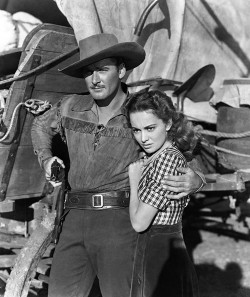Cinema | August 12th, 2015

The year 1939 was notable for many things, from the September outbreak of World War II in Europe, to the New York World’s Fair showcasing hopes for a peaceful and prosperous technology-based future, to the introduction of regular broadcast television for the American public, to the year’s unusually high percentage of enduringly popular classic films. The year’s film output includes the timeless and beloved “The Wizard of Oz” and “Gone With the Wind,” but over twenty 1939 titles are currently available on Blu-ray in nice restorations. While that’s still a tiny fraction of the total films made, and includes only six of the ten “Best Picture” Oscar nominees, 1939 is the best-represented year on Blu-ray for vintage films before 1949. Many of these 1939 productions are now celebrating the 75th anniversary of their general theatrical releases, and over the next several weeks I’ll go over some of that “golden” year’s highlights that have made it to Blu-ray.
Throughout 1939, the major Hollywood studios revived the idea that Westerns could be serious entertainment made by prestigious directors for mass audiences, instead of low-budget program pictures relegated to the avid genre fans and kiddie matinees. That January, 20th Century Fox released Henry King’s “Jesse James.” In March United Artists released John Ford’s “Stagecoach” and Warner Brothers released Lloyd Bacon’s “The Oklahoma Kid,” followed by Michael Curtiz’s “Dodge City” in April. Cecil B. DeMille’s epic “Union Pacific” came out in May from Paramount. By December, Universal would release George Marshall’s satire on the genre, “Destry Rides Again.” All have been on DVD for some time, but this June “Dodge City” became only the third out of those six released to Blu-ray, as part of Warner Video’s five-film box set called “The Golden Year 1939,” and as a standalone disc.
Available on crisp Blu-ray editions for comparison are four much lower-budget 1939 westerns made by Republic Pictures with John Wayne before “Stagecoach” turned him into a major star: “Frontier Horizon,” “The Night Riders,” “Three Texas Steers” and “Wyoming Outlaw” (the latter co-starring North Dakota native Leroy Mason as the villain). These four films demonstrate the slickly-made but more routine and formulaic Westerns audiences were used to, each running under an hour.
“Dodge City” is very much an archetypal Hollywood Western, produced by Hal Wallis with a script by Robert Buckner, combining several traditional plot formulas with a majority of the familiar iconography audiences would expect from a Western. First and foremost is the dominant theme pervading almost every Western – the bringing of law and order to a wild frontier, along with the trappings of civilization. Tying directly into this are the motifs of the railroad’s role in western expansion, the wagon trains of new settlers, and a fair-minded but free-spirited drifter reluctantly taking on the job of sheriff. We also get comic sidekicks, a kindly doctor, a crusading newspaper, buffalo hunters, a cattle stampede, barroom brawls, dance hall girls, temperance meetings, street shootouts, lynch mobs and, of course, the obligatory villain who runs the saloon and the whole town by force.
As usual, throughout it all there’s a stormy romance between two people who initially detest each other’s attitudes but gradually come to see each other’s good points. Everything is done with all the gloss and polish that a major studio could provide with a generous budget, including an A-list cast of major stars and renowned character actors, an extravagant production design and the attraction of lush Technicolor cinematography (by Sol Polito) to show it all off at a time when few films were being made in color. There’s also a rousing music score by Max Steiner.
Errol Flynn stars as an Irish immigrant who’d served in the British army, now content helping to build railroads and drive cattle north from Texas with a couple of hard-drinking, hard-living buddies, played by Alan Hale and Guinn “Big Boy” Williams. He decides to stop awhile in Dodge City, partly to deal with the rampant lawlessness revolving around a mercenary old adversary (Bruce Cabot), who’s been terrorizing the citizens since he settled in the town, and partly inspired by the feisty but beautiful niece (Olivia de Havilland) of the beloved and practical town doctor (Henry Travers). Cabot’s attractive singer-girlfriend is played by a vivacious Ann Sheridan, his vicious henchman is played by a snarling Victor Jory, and the honest newspaper editor by the affable Frank McHugh.
Under the direction of Curtiz, it all makes for an entertaining blend of colorful action and romance with a touch of Hollywood-style mythic history and satisfying resolution supporting American ideals. There are enough plot threads and character backstory that the film could easily go on another hour, but pacing generally moves right along at its running time of an hour and forty-four minutes with no time wasted (although the barroom brawl does seem slightly drawn out). It’s the kind of film that inspires multiple viewings, especially with such a sharp, clear copy, and remains great fun every time one decides to revisit it.
Picture quality on Warner’s Blu-ray of “Dodge City” is outstanding. Its pristine HD image displays the rich Technicolor hues with a film-like texture of grain that makes it look like seeing it opening night in 1939. The audio is very good overall, but it does not have a wide dynamic range and seems mildly distorted in louder portions. Bonus features unfortunately are all standard-definition, but include a “Warner Night at the Movies” selection of shorts -- a 1939 trailer to “The Oklahoma Kid,” wartime newsreel, patriotic short, and cartoon, with an introduction by Leonard Maltin -- besides a promotional trailer for the movie itself and a 2005 featurette discussing the film’s significance.
“DODGE CITY”on Blu-ray – Movie: A / Video: A / Audio: A- / Extras: B-
January 5th 2026
December 29th 2025
December 29th 2025
December 16th 2025
December 9th 2025
__293px-wide.jpg)
_(1)__293px-wide.png)


__293px-wide.jpg)
